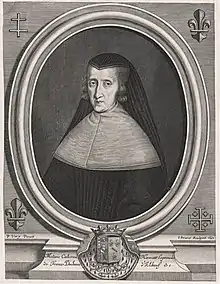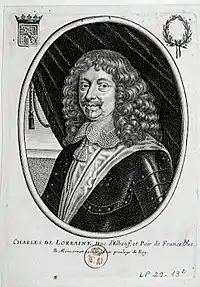Catherine Henriette de Bourbon
Catherine Henriette de Bourbon (11 November 1596 – 20 June 1663) was an illegitimate daughter of King Henry IV of France and his long-term maîtresse en titre Gabrielle d'Estrées. She was declared legitimate on 17 November 1596 at the Abbey of St. Ouen in Rouen and married into the Princely House of Guise.
| Catherine Henriette de Bourbon | |||||
|---|---|---|---|---|---|
| Légitimée de France Duchess of Elbeuf | |||||
 Catherine in 1659 as a widow, by P Vary | |||||
| Born | 11 November 1596 Rouen, France | ||||
| Died | 20 June 1663 (aged 67) Hôtel d'Elboeuf, Paris, France | ||||
| Spouse | Charles II, Duke of Elbeuf | ||||
| Issue Detail | Charles III, Duke of Elbeuf François Louis, Count of Harcourt François Marie, Prince of Lillebonne | ||||
| |||||
| House | Bourbon | ||||
| Father | Henry IV of France | ||||
| Mother | Gabrielle d'Estrées | ||||
Early years
Born on 11 November 1596 in Rouen, France,[1] Catherine was baptised on 17 November 1596. At her birth, Queen Elizabeth I of England sent a special ambassador who also proposed a new treaty between the two nations.
In her youth, Catherine was known as Mademoiselle de Vendôme, derived from the Duchy of Vendôme which had been in possession of the House of Bourbon since 1393. When she was just three, her 26‑year‑old mother died of an attack of eclampsia after giving birth to a stillborn child. As a result of her mother's death, Catherine Henriette inherited her wealth in her own right. Her mother's duchy, Beaufort, was given to her older brother, César.
Marriage

It was discussed that Catherine should marry Henry, Prince of Condé, but the idea was dropped. She married Duke of Elbeuf, born Charles de Lorraine at the Palais du Louvre in Paris on 20 June 1619.[2]
The dowry was 1.3 million livres and included pensions as well. Most of this money was spent and re-mortgaged for various reasons including a failed lawsuit against her brother César.[3]
As Catherine Henriette was marrying into the House of Guise, she took on the style of Highness, the Guises being foreign princes at court. After her marriage, she was known as the Légitimée-duchesse. She used to sign documents as C H. L de France – Catherine Henriette. Légitimée de France.
Catherine's husband died in Paris at the Hôtel d'Elboeuf, the family town house. She remained a widow until her own death in 1663.
Issue
- Charles III of Elbeuf (1620–4 May 1692)
- Henri (1622–3 April 1648) never married; Abbot of Hombieres
- François Louis, Count of Harcourt (1623–27 June 1694), married and had issue;
- François Marie, Prince of Lillebonne (4 April 1624 – 19 January 1694); married and had issue
- Catherine (1626–1645)
- Marie Marguerite (1629–7 August 1679) known as Mademoiselle d'Elboeuf; died unmarried and childless
References and notes
- Pitts 2009, p. 217.
- Gerber 2012, p. 81.
- Spangler 2009, p. 154.
Sources
- Gerber, Matthew (2012). Bastards: Politics, Family, and Law in Early Modern France. Oxford University Press.
- Pitts, Vincent J. (2009). Henri IV of France: His Reign and Age. The Johns Hopkins University Press.
- Spangler, Jonathan (2009). The Society of Princes; the Lorraine-Guise and the conservation of power and wealth in the Seventeenth Century. Ashgate.
